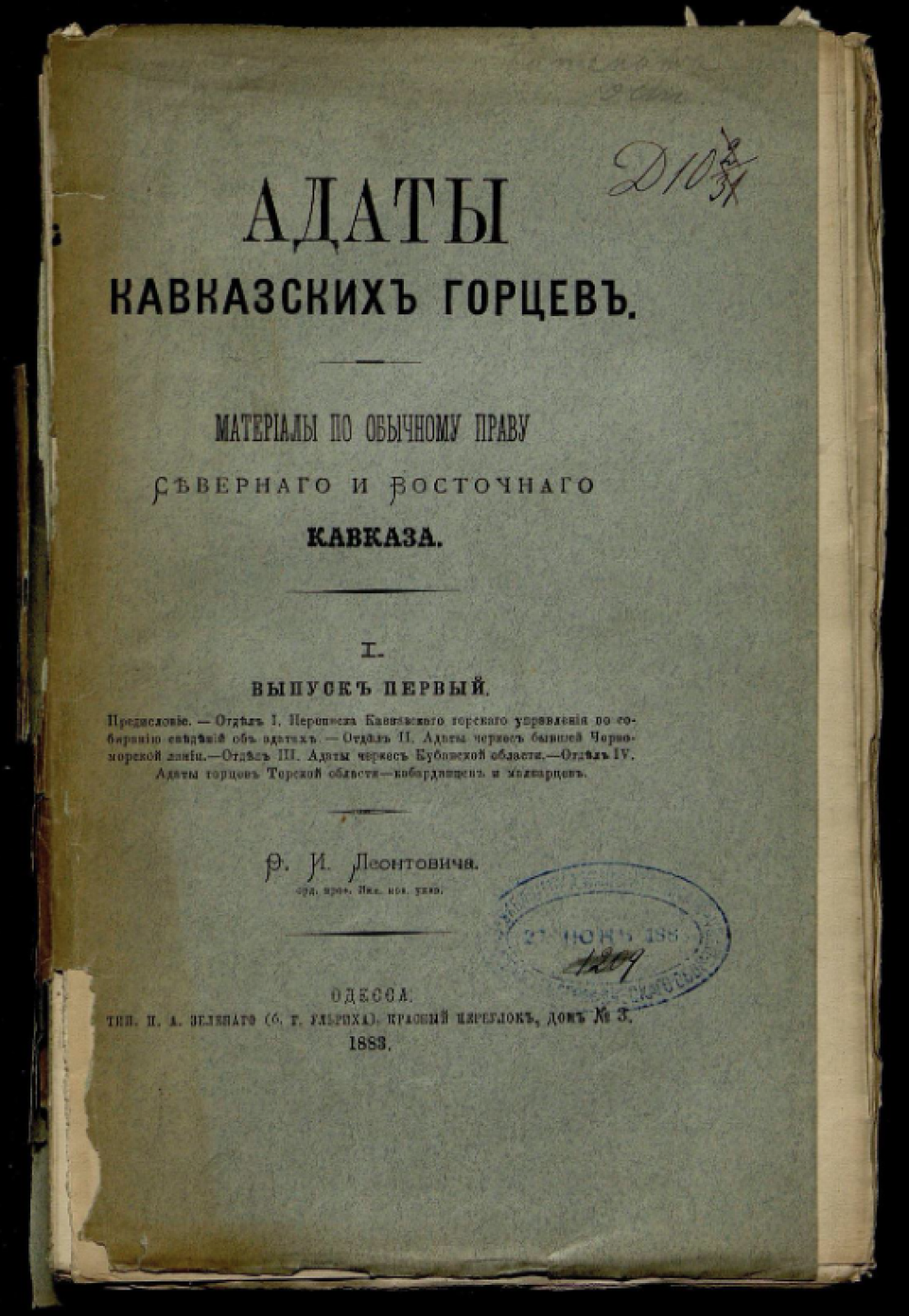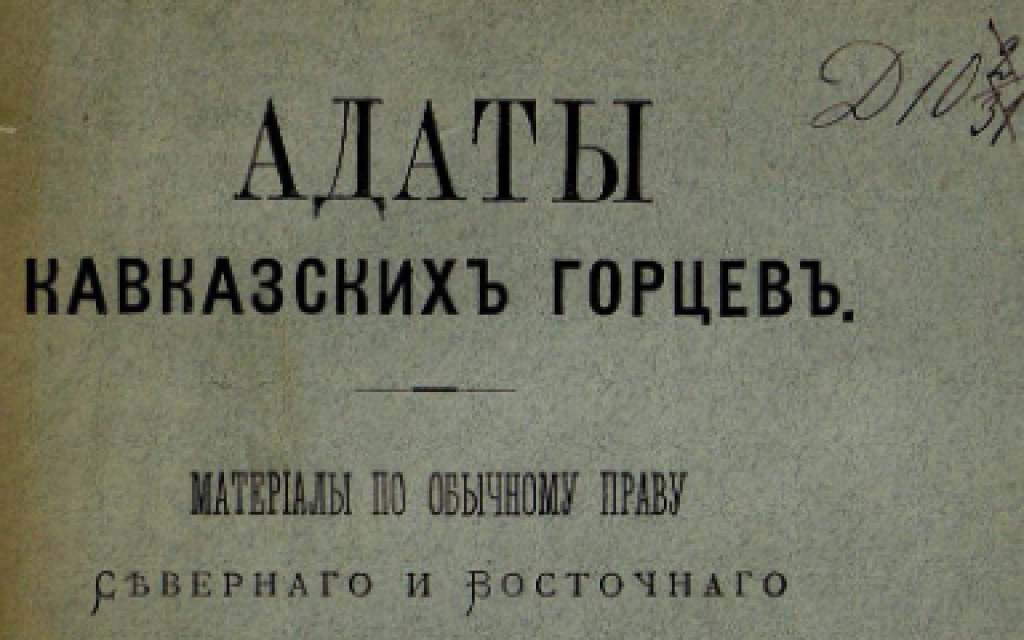Sergey Salushchev is a historian of the Caucasus region and a lecturer in the Department of History at UC Santa Barbara. His dissertation, Reluctant Abolitionists: Slavery, Dependency, and Abolition in the Caucasus (1801-1914), investigates the history of slavery, the slave trade, and abolition in the nineteenth-century Caucasus under Russian imperial rule.
Slavery was a deeply ingrained social institution in the North Caucasus. As in other societies with slaves, slavery in the North Caucasus spilled well beyond the economics of coerced labor, becoming firmly interlaced with local traditions, including institutions of retributive justice. The custom of blood revenge stands out as the most infamous example of this connection.
In the Caucasus, as the saying goes, “tempers fly short while memories run deep.” This adage is an apt observation that historians interrogating the region's history echo both in ink and spoken word. Although such psychohistorical conclusions are not unique to the Caucasus, they do bring into focus the pervasiveness of the custom of blood revenge in the region.
Blood revenge has been the subject of ennobling myths and cruel reality in the history of the North Caucasus. Beginning from the late eighteenth century, Russian imperial ethnographers were quick to pathologize the custom and ascribe it to a “traditional” culture of violence among mountain dwellers in a process of colonial knowledge production described by Vladimir Bobrovnikov. Standing at the intersection of local conceptions of justice, honor, and eclectic tenets of customary law, blood revenge (or the threat thereof) has for centuries influenced intercommunal relations. It continues to influence the mores and conduct of people living in the region today.
Conceived as a social safety net, blood revenge promised to maintain peace. It stipulated collective liability for particularly grave transgressions, extending responsibility to an individual's entire family clan. In theory, such a system of collective accountability would discourage violence. However, for numerous reasons, blood revenge did not and could not emerge as an effective deterrent against unprovoked violence. On the contrary, rather than sustaining peaceful intra-communal relations, it frequently engendered bitter multigenerational feuds.
Adat, the customary law in the North Caucasus, was the prime source of judicial and penal authority in numerous communities in the region. Adat recognized the potentially devastating consequences of blood revenge. It offered practical alternatives to violent retributions for settling blood feuds and breaking the cycle of generational animosity and vengeance between different families. The most common means for such reconciliations was the payment of restitution to the victim’s family. Since cash was in very short supply in the Caucasus until the late nineteenth century, other valuable commodities were used for in-kind payments of compensation. The high monetary value of enslaved people in the region made them a lucrative asset for settling blood revenge conflicts.
The institutions of slavery and slave trading were common and widely accepted practices across much of the Caucasus mountains for many centuries. Slavery was particularly entrenched in the North Caucasus, where it coexisted with other forms of personal dependency and unfree labor. The demise of chattel slavery in the region came gradually following a series of incremental emancipatory reforms instituted by the Russian colonial authorities in the late 1860s and 1870s. These reforms marked the arrival of the epoch of Alexander II’s Great Reforms in the imperial periphery. However, until slavery and the slave trade were dismantled in the North Caucasus, enslaved people remained a significant investment and a mark of prestige for their owners.
Just how common it was to settle blood feuds by transferring the ownership of enslaved people from one family to another becomes evident when leafing through the archives of the Russian imperial administration in the region. Adat laws existed primarily as an oral tradition of local institutions of justice, which was passed on from one generation of elders to the next. However, the surveying endeavors and interviews conducted by imperial officials in the North Caucasus preserved compilations of some of these laws in a physical archive.
For instance, according to adat recorded in the Ossetian region of Digora, the murder of a person from the noble class of landowners known as badiliat required the payment of 15 enslaved people whose monetary value varied depending on their age and gender. At least four of these enslaved people were to be valued at 300 silver rubles each. In the event that the guilty party could not deliver all of the enslaved people required by the customary law, the adat permitted substituting them with items of commensurate monetary value such as a horse, rifle, sword, cookware made of copper, and other valuable items. Further, an injury inflicted on a badiliat that did not cause fractured bones could be settled for the payment of one enslaved person whose value equaled 300 silver rubles. More serious injuries that caused permanent disability or disfigurements required the payment of seven enslaved people.
Reflecting the hierarchical social composition of the indigenous communities in the North Caucasus, adat measured one’s status through chattel slavery. Consequently, the right to claim enslaved people as restitution for crimes that called for blood revenge was generally reserved for the social elites. In the Ossetian community of Tagaura, for instance, adat prescribed payment of "a specific number of cows (up to 400), surrender of arable land commensurate with the cost of 18 cows, a rifle, a horse, and an enslaved woman valued at 30 cows" for the murder of an aldar (a nobleman). In contrast, the reconciliation of blood feuds for the murder of a commoner according to adat required payments consisting of cattle, land, silk fabric, and/or a cash equivalent of 1,400 silver rubles.
Customary laws in the North Caucasus denied enslaved people personal rights, equating them with livestock and everyday items of barter. Thus, the murder of an enslaved person did not entitle their family the right of seeking blood revenge or to receive restitution of any kind. Instead, adat assigned the enslaved person’s owner as the beneficiary who was entitled to receive compensation for their loss or damage of “property” equal to the price originally paid for the enslaved person. If the enslaved person was born in the household of their owner, adat stipulated that a trustworthy mediator be appointed to determine a fair settlement for the murder.
The institution of slavery in the North Caucasus became firmly embedded in the local system of retributive justice. The high value placed on the ownership of enslaved people is seen plainly in the cases of blood revenge that adat sought to resolve without violence. Adat in Chechnya, Dagestan, Circassia, Ingushetia, and Ossetia encouraged peaceful settlement of blood feuds through payments of blood money to the victim's family. However, this "peace" came at a high cost: the vicious cycle of enslavement and the slave trade. Further, as the vehicle for resolution of blood revenge conflicts, slavery revealed the hierarchical essence of the social structure of these societies. Each community's adat typically placed a higher value on the life and wellbeing of the nobility. Historical records suggest the common folk resented the privileged status of the nobles, but never questioned the validity of chattel slavery itself.




